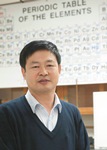Org. Synth. 2014, 91, 116-124
DOI: 10.15227/orgsyn.091.0116
Preparation of Alkanesulfonyl Chlorides from S-Alkyl Isothiourea Salts via N-Chlorosuccinimide Mediated Oxidative Chlorosulfonation
Submitted by Zhanhui Yang and Jiaxi Xu
1*
Checked by Miika Karjomaa, Yoichi Hirano, and Keisuke Suzuki
1. Procedure
During the process, there may be chlorine gas generated, so the experiments should be performed in a well ventilated hood.
A. S-Benzyl Isothiouronium Chloride (1). A 500-mL one-necked pear-shaped flask equipped with a 3-cm oval magnetic stir bar is sequentially charged with thiourea (19.1 g, 250 mmol, 1 equiv) (Note 1), benzyl chloride (31.7 g, 250 mmol, 1 equiv) (Note 2) and ethanol (250 mL) (Note 3). Then the flask is equipped with a condenser and the reaction mixture is heated to reflux with a 96 °C oil bath (Φ = 18 cm, h = 11 cm) and stirred for 1 h. After the reaction mixture is cooled to ambient temperature, the ethanol is removed on a rotary evaporator (25 mmHg, 55 °C), and 57.9–65.7 g of a white solid is obtained as the title product 1 in quantitative yield (Note 4). Without further purification, the solid is ground with a ceramic mortar and pestle and used directly in Procedure B.
B. Phenylmethanesulfonyl chloride (2). A 1-L three-necked round-bottomed flask is sequentially charged with N-chlorosuccinimide (133.5 g, 1000 mmol, 4 equiv) (Note 5) and MeCN (400 mL) (Note 6). The flask is immersed into a 10 °C water bath (Φ = 24.5 cm, h = 16 cm) and equipped with an overhead mechanical stirrer (paddle size: w = 8 cm, h = 1.5 cm), a thermometer fitted with a thermometer adapter and an addition funnel. After addition of 2 M HCl (70 mL), the addition funnel was exchanged with a solid-addition funnel. After the mixture is cooled to about 10 °C, the ground S-benzyl isothiouronium chloride solid (50.7 g, 250 mmol, 1 equiv) is slowly added through the solid addition funnel over the course of 30 min. In the initial 7-10 min of the addition, the reaction mixture turns into a clear yellow solution. During the addition, the temperature of the reaction mixture is kept below 30 °C. When the temperature reaches 25 °C, the addition is paused to allow the temperature to decrease to around 15 °C. Residual solid on the spatula, the solid-addition funnel and the addition neck of the flask is washed into the reaction mixture with a portion of the reaction mixture (15 mL) and then MeCN (10 mL). The 500-mL pear-shaped flask used in Step A is also rinsed with a portion of the reaction mixture (20 mL) and then with MeCN (20 mL). The resultant yellow solutions are transferred into the reaction system. The reaction mixture is stirred for an additional 15 min to completely consume the starting material (Note 7). Tap water (300 mL) is added to the flask using an addition funnel and a white precipitate forms. Half of the heterogeneous solution is transferred into a 1-L flask and MeCN is removed on a rotary evaporator (1 mmHg, 15 °C). The remaining half is transferred to the same 1-L flask and again the MeCN is removed on a rotary evaporator (1 mmHg, 15 °C). A large amount of white solid appears in the flask. The solid is collected by filtration through a Büchner funnel (Φ = 10 cm) and washed with tap water (100 mL) (Note 8). The white solid is transferred into a 1-L one-necked flask and dissolved in MeCN (300 mL), followed by an addition of tap water (150 mL). The resultant mixture is evaporated on a rotary evaporator (1 mmHg, 15 °C) to remove the MeCN and again a large amount of white solid appears. The solid is collected by filtration through a Büchner funnel (Φ = 10 cm) and washed with tap water (100 mL). The white solid is transferred into a 1-L Erlenmeyer flask, dissolved into CH2Cl2 (300 mL) (Note 3) and dried over Na2SO4 (40 g) (Note 3). The dried solution is filtered into a 1-L one-necked pear-shaped flask through a sintered funnel and washed with CH2Cl2 (150 mL). The solvent is removed on a rotary evaporator (25 mmHg, 55 °C) and the resulting white solid is dried for 2 h at 0.5 mmHg in a vacuum drying oven (40 °C) (Note 9
). The desired product 2 is obtained as a white solid (39.4–40.9 g, 83–86%) (Note 10).
2. Notes
1. Checkers purchased
thiourea (≥99%) from Tokyo Chemical Industry Co., Ltd. and used it as received. Submitters purchased
thiourea (≥99%) from Beijing Gaili Fine Chemical Co., Ltd. and used it as received.
2. Checkers purchased
benzyl chloride (≥99%) from Tokyo Chemical Industry Co., Ltd. and used it as received. Submitters purchased
benzyl chloride (<≥99%) from Beijing Xingjin Chemical Factory and used it as received.
3. Checkers purchased
ethanol (≥99.7%) from Wako Pure Chemical Industries,
dichloromethane (≥99.5%) from Asahi Glass Co., Ltd. and anhydrous
sodium sulfate (≥99%) from Shikoku Chemical Co. Submitters purchased
ethanol (≥99.7%),
dichloromethane (≥99.5%) and anhydrous
sodium sulfate (≥99%) from Beijing Chemical Works and both checkers and submitters used the above mentioned chemicals as received.
4.
S-Benzyl isothiouronium chloride has the following physical and spectroscopic properties: The crude solid started melting at 100 °C, but decomposed (turned brown) at 167 °C. The remaining solid turned liquid at 182 °C.
1 H NMR
pdf(600 MHz, D
2O) δ: 4.41 (s, 2 H), 7.40–7.55 (m, 5 H);
13C NMR
pdf(600 MHz, D
2O) δ: 35.1, 128.5, 128.9, 129.1, 134.2, 170.5. Anal. calcd. of the crude material for C
8H
11ClN
2S: C, 47.40; H, 5.47; N, 13.82; S, 15.82. Found: C, 46.39; H, 5.45; N, 14.66; S, 16.80.
5. Checkers purchased
N-chlorosuccinimide (≥98%) from Kanto Chemical Co., Ltd. Submitters purchased
N-chlorosuccinimide (≥98%) from Beijing Ouhe Technology Co., Ltd. and both checkers and submitters used the chemicals as received.
6. Checkers purchased
MeCN (≥99%) from Nacalai Tesque Inc. Submitters purchased
MeCN (≥99%) from Tianjin Fuchen Chemical Reagents Factory and both checkers and submitters used the chemicals as received.
7. When the submitters performed the procedure, the temperature of the tap water was about 10 °C, so they directly used the tap water in the water bath.
8. The reaction process is monitored by TLC on silica gel 60 F
254 plate. For
phenylmethanesulfonyl chloride, R
f = 0.67 (hexanes:EtOAc = 5:1 v/v); for
S-benzyl isothiouronium chloride, R
f = 0.28 (CHCl
3:MeOH = 9:1 v/v). Plates were visualized by UV and an acidic phosphomolybdic acid stain [preparation: phosphomolybdic acid (11 g), sulfuric acid (23 mL), phosphoric acid (6.8 mL) and water (455 mL)].
9. Submitters reported that upon drying under an infrared lamp, the product was contaminated with trace amount of succinimide as indicated by
1H NMR. However, when the product is synthesized on 50-mmol scale, this problem can be avoided. Checkers observed from
1H NMR that the product was contaminated with < 1% of succinimide.
10.
Phenylmethanesulfonyl chloride has the following physical and spectroscopic properties: mp 91–93 °C;
1H NMR
pdf(600 MHz, CDCl
3) δ: 4.86 (s, 2 H), 7.43–7.51 (m, 5 H);
13C NMR
pdf(600 MHz, CDCl
3) δ: 70.9, 126.1, 129.2 (2C), 130.3, 131.4 (2C); Anal. calcd. for C
7H
7ClO
2S: C, 44.10; H, 3.70; S, 16.82. Found: C, 44.05; H, 3.71; S, 17.01. IR (ATR): 2991, 2920, 1363, 1157, 1136, 772, 692 cm
-1. When the checkers dried the product, a small amount of product sublimed and formed colorless needles on the aluminum foil covering the beaker. The crystals were separated, identified by
1H NMR as product, and combined with the bulk material for characterization.
Handling and Disposal of Hazardous Chemicals
The procedures in this article are intended for use only by persons with prior training in experimental organic chemistry. All hazardous materials should be handled using the standard procedures for work with chemicals described in references such as "Prudent Practices in the Laboratory" (The National Academies Press, Washington, D.C., 2011 www.nap.edu). All chemical waste should be disposed of in accordance with local regulations. For general guidelines for the management of chemical waste, see Chapter 8 of Prudent Practices.
These procedures must be conducted at one's own risk. Organic Syntheses, Inc., its Editors, and its Board of Directors do not warrant or guarantee the safety of individuals using these procedures and hereby disclaim any liability for any injuries or damages claimed to have resulted from or related in any way to the procedures herein.
3. Discussion
The alkanesulfonyl chlorides represent an important class of compounds that have been widely applied as intermediates in synthetic organic chemistry and as building blocks in medicinal chemistry. In general, these compounds can be accessed (1) by chlorination of the corresponding sulfonic acids or their sodium salts with chlorinating reagents,
2 or (2) by oxidative chlorosulfonation of sulfur-containing compounds such as thiols, disulfides, thioacetates and thiocarbamates by oxidizing reagents. The first method suffers from drawbacks such as harsh conditions, long reaction time, low functional group tolerance, required use of an excess of chlorinating reagents, and the formation of acidic and/or toxic byproducts. The second method always involves the use of hazardous and toxic chlorine gas, which is not conveniently handled in laboratory operation. Therefore, a series of mild oxidizing reagents such as H
2O
2-SOCl
2,
3a, 3b, 3c, 3d O
3-SOCl
2,
3e SO
2Cl
2-KNO
3,
3f Br
2-POCl
3,
3g NCS-HCl,
3h, 3i, 3j, 3k and TMSCl-KNO
33l have been developed to overcome the drawbacks of chlorine gas. However, most of the substrates employed in these reactions have strong and repulsive odors, and these substrates have the potential to do great harm to environments and human health.
The present procedure describes a convenient preparation of alkanesulfonyl chlorides via
N-chlorosuccinimide-mediated oxidative chlorosulfonation of
S-alkyl isothiourea salts, of which the oxidative chlorosulfonation mediated by chlorine gas was firstly reported by Sprague and coworkers.
4 In this preparation, the drawbacks of both the pollutant thiol derivatives and hazardous and toxic chlorine gas are successfully overcome. The procedure is a convenient, environment- and worker-friendly method to synthesize alkanesulfonyl chlorides.
Appendix
Chemical Abstracts Nomenclature
(Registry Number)
Thiourea; (62-56-6)
Benzyl chloride; (100-44-7)
N-Chlorosuccinimide; (128-09-6)
S-Benzyl isothiouronium chloride; (1) (1334419-16-7)
Phenylmethanesulfonyl chloride; (2) (1939-99-7)

|
Jiaxi Xu received his B. S. and Ph. D. degrees in chemistry at Peking University, followed by postdoctoral studies at Beijing Medical University. He also worked as a visiting scholar at the Chinese University of Hong Kong, and as postdoctoral fellow at Colorado State University and Vanderbilt University. He was nominated professor at Peking University in 2004. He moved to Beijing University of Chemical Technology in 2007. His scientific interests focus on the organic synthesis, asymmetric catalysis, and peptide chemistry.
|

|
Zhanhui Yang was born in 1987 and raised in Xuchang County, He’nan Province, China. In 2010, he received his B. S. degree from Beijing University of Chemical Technology. He is currently pursuing his doctoral studies under the supervision of Prof. Jiaxi Xu at the same university. His research now focuses on the simple and green synthesis of important sulfonic acid derivatives, the formation mechanism of ß-sultams via reactions of sulfonyl chlorides and imines, and the carbene (carbenoid) reactions of diazosulfonyl compounds.
|

|
Miika Karjomaa was born in 1990 in Finland and he was accepted to Aalto University School of Chemical Technology in 2010. He completed his Bachelor’s thesis on “Industrial applications of the Baeyer-Villiger reaction” in 2013. Currently, he is continuing his studies at the Suzuki-Ohmori laboratory in Tokyo Institute of Technology.
|

|
Yoichi Hirano was born in 1989 in Tokyo, Japan. He received his BS degree from Tokyo Institute of Technology in 2011, after which he continued his graduate studies in Professor Keisuke Suzuki’s group. His study focuses on the synthesis of natural products
|
Copyright © 1921-, Organic Syntheses, Inc. All Rights Reserved